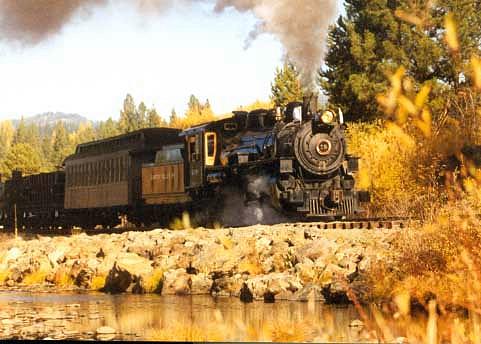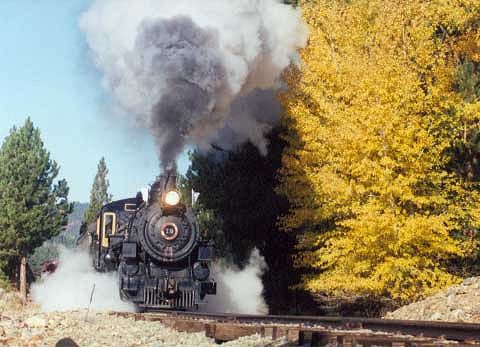Sumpter Valley Railway
Reprinted from "Crown Jewels of the Wire", June 2003, page 23
"I've got bucket loads of insulators I want to get rid of," the
woman told me over the phone. "My husband salvaged them years ago off a
railroad in Northeast Oregon."
She instantly had my interest. I often
advertise to buy insulators in want-ad newspapers. Her's was a response to such
an ad.
The woman lived in a town that's about a two hour drive from my place.
When I visited her a couple of weeks later, she explained that her deceased
husband had spent his career as a railroad conductor. At some point in the
1970's, he gathered some 500 insulators from the Sumpter Valley Railway, located
not too far from Baker City, Oregon.
I'm familiar with the railway, having
walked sections of it just a year ago. There are downed poles all along the
route, and broken pieces of two piece transpositions, hundred year old pony and
beehive styles, as well as newer insulators.
Construction of the Sumpter Valley
Railway began in 1890, running up the Powder River Valley from Baker City. The
narrow gauge line was completed as far as a stage coach stop named McEwen in
1891. But the very next year, a new gold strike occurred near a mining community
called Sumpter creating an economic boom for the area.
But that's not to say the
Sumpter Valley Railway was in any hurry to go anywhere. The railroad tracks
weren't completed the six miles from McEwen to Sumpter until 1896. By then
Sumpter was boasting of a population of 9,000 people.

When the mines began to
decline a decade later, the railway gradually extended further and further into
the mountains... for logging purposes. By 1901 the line went over Larch summit,
5,094 feet above sea level on the side of Huckleberry Mountain. In the valley
beyond, the Oregon Lumber Company built a logging town called Whitney. The place
remains standing today, a ghost reminder of busier times. Drive into Whitney, by
the way, and you'll still see common insulators in the yards outside several
cabins.
In 1903, crews extended the rails beyond the North Fork of the Burnt River,
and over Tipton Summit (5,127 feet) in the Greenhorn Mountains. In 1905 the line
reached White Pine, then Austin. Finally, in 1910, the railway descended to the
John Day River Valley and halted at a town called Prairie City. It had taken 20
years for the Sumpter Valley Railway to extend the grand distance of 80 miles
from Baker City.
Not that some people didn't have grand plans for the railway. One developer
dreamed of snaking it down through all of Eastern Oregon and on to Reno, Nevada.
But it wasn't to be.
Trains stopped coming to Prairie City during the Great
Depression. Passenger service between Baker City and Sumpter ended in 1937. A
daily freight train ran for another ten years, and paying passengers.. if there
were any... had to ride in the caboose.
The last freight train pulled into Baker
City in 1947. After that, the rails were removed and the rolling stock was sold.
But one thing persisted. The communication lines alongside the tracks continued
to carry the region's telephone conversations for another 25 years. I recall the
phone lines still being up the first time I visited Sumpter. It was on an
insulator hunting trip in 1968. A friend and I went to the region to hunt for
Provo insulators, which were in use throughout the area at the time.
Today, the Sumpter Valley Railway is running again. Historical restoration
began in 1971. An original engine and other rolling stock were located and
returned. Track construction started once again, and the narrow gauge was back
in business for short runs by July 4, 1976. Volunteers, and a donation from the
only surviving family member of the original owner of the railroad, made it
possible to extend tracks back to Sumpter by 1991. Today, the route is five
miles long.
To get there, take Highway 7 out of Baker City. You will know you
are close when you get to historic McEwen. Oh, when you turn off the highway to
head for the depot, take note of the first power pole on the left. As of a year
ago, that pole was still sporting a Provo in use.
Other great power insulators
can also still be admired in that area. The state of Oregon is renovating a
historic power plant not far from a town called Granite. At the Fremont
powerhouse are numerous Lima porcelain multipart insulators. Remember the trip I
took in 1968? All we found out of service and abandoned on the ground were
porcelain multiparts. We weren't interested in "mud" in those days,
and left them all behind. Now I wonder how many of them were Lima's.
What about
those bucket loads of insulators the woman had for sale? I bought them. So, were
they full of two-part transpositions and colorful beehives? Not! Apparently
insulator collectors got to the abandoned telephone lines before the railroad
conductor did.
Those buckets had been around so long the bottoms had rusted
through on most of them. And out of them I pulled hundreds of aqua and clear
glass Hemingray #9's, Brookfield ponies, Hemingray 12's, clear Hemingray 14's,
clear Hemingray 16's, and a few stray McLaughlin's and Maydwell's. There wasn't
a single insulator that was in the slightest bit unusual or scarce.
Howard Banks

(You can learn more about the Sumpter Valley Railway at the historic
railroad's web site: www.svry.com Or, for ticket information to ride the
historic train, call 541-894-2268. Photos are all scenes from the Sumpter
Railway.)
| 